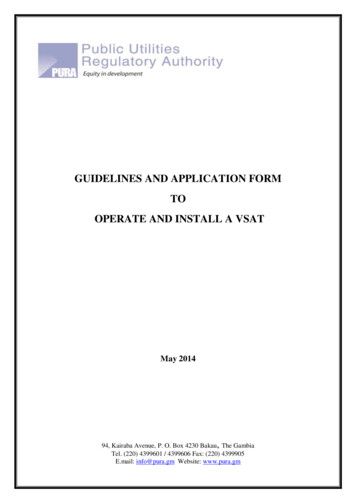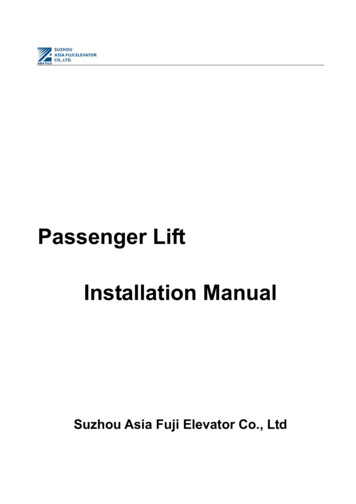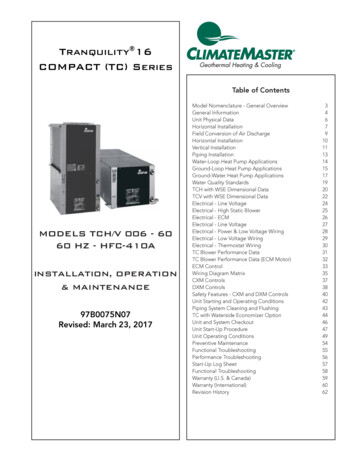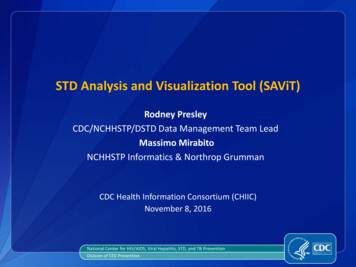
Transcription
VSAT Installation and Maintenance
What is a VSAT?A VSAT ( Very Small Aperture Terminal) is a type of Satellite EarthStation (SES) or simply “E/S” that is designed and built purposely for“ender- user” deployment.2
How “small” is a VSAT? VSATs as the name implies are characterised bya “ very small” “aperture” Satellite antenna belongs to the class ofantennas that have a parabolic-shaped “mirror”or “ reflector” that focuses electromagneticwaves to its focal point where the feed islocated. But as the shape of parabolic antenna is similarto that of a household dish, the antenna is alsocommonly referred to as a “Dish”. The reflector diameter of a VSAT rangesbetween about 3.8 m and 0.6 m The weight of the outdoor hardware may beanything from 50 kg to 500 kg including themouthing hardware3
Typical setting for VSAT Installions4
VSAT hardware list1/3VSATs ( Very Small Aperture Terminal) come in a variety ofconfigurations and sizes depending intended application, band ofoperation, and network topology.However for any VSAT, we can group the hardware into two: Outdoor unit assembly Indoor unit assembly5
Sample Hardware list2/3The outdoor unit assembly consists of: 1.2 m antenna operating in the Ku band Standard L-band LNB for the receiving signal. The LNB converts the Kuband signal received from the satellite into an L band signal. Transmitter for the transmitting signal. The transmitter converts the Lband signal transmitted from the VSAT into a Ku band signal. OMT (Orthomode Transducer) separates the transmit signal from thereceived signal, taking advantage of their different polarization andfrequency. Two IFL cables connecting the indoor unit assembly with the outdoorunit assembly. The IFL (Inter-Facility Link) cabling carries the inboundand the outbound signals and the 24 VDC for the LNB.6
Sample Hardware list3/3The indoor unit assembly consists of the Indoor Unit (IDU) witch containsthe following: The Modulator The Demodulator Two serial and one Ethernet port.7
VSAT installation Flowchart1/2StartLine of ionImpossibleYESYESInterferenceFind AlternativePositionFind netratingMount?8
VSAT installation Flowchart2/29
Site Survey Checklist Absence of high-rise buildings, trees etc, which may block theLine of Sight ( LOS). Absence of interference Existence of AC power (required during installation) Existence of a clear, unobstructed line of sight to thedesignated satellite Note the longitude and latitude of site ( or confirm LBAassumption) Existence of a LAN network near the IDU. Estimation of the maximum cable length. Free access to the roof of the building (if roof top installation)10
“Work arounds” to avoid LOS obstructionsAbsence of high-risebuildings, trees etc,which may block thesignal path.If the elevation isbetween 30 and 60 Imagine an arc rangingfrom 30 to 60 degreesabove the horizon.11
Questions so far?12
Dish AssemblyA properly assembled sat dish.13
Dish AssemblyFactory preassembled mount.Fine azimuth andelevationadjustmentsRF electronics (LNB &BUC).14
Feed, BUC, LNB, RF CablesFeed AssemblyLNBRG11LMR 400BUC15
VSAT MOUNT16
Check list for Indoor Unit (IDU) Installation The IDU includes a fan for ventilation. To allow proper airflow and toguarantee safe operation of the VSAT equipment, make sure that: The rear panel of the IDU is not covered.The IDU is not placed in an unventilated enclosure.At least 10 cm of space along the IDU sides are left for ventilation.The maximum ambient temperature is 50 oC.Place the IDU where it can be easily accessed by a technicianduring maintenance. Place the IDU away from electromagnetic field emitting devices.17
Roof Installations If penetrating the roof is allowed, secure the pole to the roof withpenetrating large bolts. Apply silicon for additional rain protection. In case penetration of the roof is not possible, a non-penetratingmount should be used.18
Typical VSAT Setup19
ODU assembly and installationInstall the AZ/EL cap on the ground pole by inserting the four plowbolts into the holes in the reflector face and insert the exposedportion of the bolts into the holes in the antenna mount flange.Tighten the clamp nuts so that the cap is held stationary on the pole.After setting the antenna to the approximate azimuth and elevationangles, assemble and attach the ODU to the antenna as described inthe following sections.20
ODU assembly and installationAttach the LNB and the transmitter to the OMT (Orthomode Transducer)after placing the “O”- Ring on its corresponding groove on them.Verify that the wave-guide polarization is correct both in the LNB and thetransmitter.The correct polarization is set by rotating the outdoor electronics to theappropriate position (this has to be done through a phone call to theNOC).The VSAT is designed to receive and transmit on opposite polarization.21
ODU assembly and installation22
ODU assembly and installationTighten the screws. Assemble the feed legs to the antenna. Assemble thefeed mounting block to the feed support legs. Tighten the hardwaresecuring side and the bottom feed legs to the feed support block and thereflector.Place the ODU assembly on the antenna support arm. Tighten the nuts andfinally connect the two coaxial cables to the LNB OUT port and theTransmitter IN port.23
Questions so far?24
Antenna alignmentPoint your dish to the satellite, if you have a spectrum analyzer, you cansee your signal at for example 11597.408 MHz RF frequency, or 1597.408MHz L-band frequency (the output of the VSAT is L-band) and try tomaximize it by slowly turning the feeder to the left or right. Screwing thefeeder back, will have to be done extremely cautiously (one screw at atime, just 1 turn until all screws are in place)Horizontal polarization adjusted by -13 deg anticlockwise, while facing the satellite25
Antenna alignmentSet the antenna to the approximate azimuth angle and elevation angles.The exact azimuth and elevation angles come out of the exactgeographical longitude and latitude.Channel Master antenna, for example, have 17 degrees offset. The offsethas therefore to be added to the calculated elevation angle. Connect afield meter to the receive IFL cable.Set the antenna elevation, using the antenna adjust mechanism, until theinclinometer indicates the calculated elevation. Move the antenna’sazimuth and elevation until carriers are displayed on the field meter.Adjust the field meter controls.Slowly rotate the antenna for largest possible carrier amplitude. Whenfound, tighten the antenna hardware.26
IFL cable connectionsConnect the ODU to the IDU using two IFL coaxial cables as follows:Connect one IFL cable from the transmitter to the RF OUT port of the IDU.Connect the second IFL cable from the LNB to the RF IN port of the IDU.The cable length should not exceed the 30 meters for an RG 6 type cable.Use RG 11 type coaxial cable for longer distances27
Final checklistEnsure that all the cables are connected to the correct terminals and arefirmly tightened. Tie wrap cables to the antenna assembly. Leave enoughextra cable at the antenna. Tie wrap the cable to the mast. Make surethat all outdoor connectors are weatherproofed after any necessarytesting has been completed.Polarization adjustmentContact the hub operator. The final step in alignment is the Peak and Poleprocedure with the satellite operations center. They will insist on correctalignment of the antenna and the polarizer in order to insure that theantenna is not interfering with adjacent satellites or with other poles onthe same satellite.28
Configuring the IDU 1/4Follow the supplier’s provided configurations instructions. Typically forVSAT remotes working off a hub, much of the configuration will be carriedout remotely from the hubFor SCPC VSATs, typically the configuration will be performed viaconfiguration port on the IDU and supplier provided cable. Follow thesupplier’s instructions29
Configuring the IDU 2/4Connecting Cables30
Modems and Sat Routers31
VSAT antenna pointing 1/532
VSAT antenna pointing 2/5Before you start radiating power towards the satellite Make sure you have a site specific Antenna and radio configuration (ARC)sheet. Schedule the installation with NOC. Make sure you have the required tools (inclinometer and compass are key) Note: The antenna and radio configuration sheet gives you’re the trueelevation (or the elevation for a prime focus antenna). In the case of offsetantennas, make sure to subtract the antenna offset form the elevation givenin the field installation documentation.33
VSAT antenna pointing 3/5Antenna Offset Examples34
VSAT antenna pointing 4/5Azimuth:Take note that a compass doesn’t work well near steel obstructions andframeworks commonly found in buildings. Strong magnetic fieldsdramatically affect compass reading as well.35
VSAT antenna pointing 5/5Using a spectrum analyzer for pointing Note:Since the LNB is powered with DC over coax it is notpossible to connect the spectrum analyzer straight to theLNB. You could blow up the spectrum analyzer input!36
Questions so far?37
Preventive Maintenance 1/5Good maintenance, knowledge of the site and well maintained records arethe basis for avoiding any unexpected faults. However, an unexpectedfailure may cause outages and emergency repairs may be necessary by theon-shift technician or VSAT technician.To meet the guarantee, and to keep the link functioning, you need tohave a regularly scheduled antenna inspection and maintenance program.38
Preventive Maintenance 2/5The lack of a well implemented preventive maintenance programcould trigger a wave of problems. An electrical or physical failurecould lead to a complete antenna failure, causing downtime oreven loss of contract. It is known that 50-70 percent of all outagesare caused by: Equipment incl. the antenna error Human error Lack of experience on equipment and test equipment Improper or mal-function test equipment.This means that most failures can be avoided and outagesMaintaining an earth station antenna is much less costly than torepairing one that has failed.39
Preventive Maintenance 3/5 Generally the maintenance procedure takes from one hour to half aday, depending on the environmental conditions under which theantenna operates. All the maintenance activities must not only be scheduled in advancewith the customer but also coordinated with the different supportorganizations in the same way installation activities are scheduled. Reliable and effective maintenance depends upon good testequipment which is regularly calibrated in accordance withmanufacturer’s recommendations40
Preventive Maintenance 4/5The lack of a well implemented preventive maintenance program couldtrigger a wave of problems. An electrical or physical failure could leadto a complete antenna failure, causing downtime or even loss ofcontract.A dated log (started from day one) with photographs should be preparedwhen the antenna (and the other parts of the site) are installed. Entriesinto the log should be made during each inspection so a complete recordof the entire antenna system and its condition is available.Maintenance logs should be stored with the equipment or within theequipment rack.41
Preventive Maintenance 5/5Check ListAppearanceHardware tighteningEarthing (or grounding) connectionsOutdoor enclosures inspectionAntenna pointingEquipment fans42
Troubleshooting1/3WHAT TO DO WHEN THINGS GO WRONGObviously, if you need help, the NOC is available. But before youcall, please take a bit of time to track down and fix your problemyourself. Ensure you are up to date with your preventivemaintenance.43
Troubleshooting2/3And don't rule out hardware errors. A great way to test this is to usean alternate bypass such as switching network cables, coax cables, or adifferent computer when all else fails.If you are having signal related problems. try to locate the error bychecking your dish.The idea is not to panic and that most problems are normally an easy fix.once the problem is located.44
Troubleshooting3/3Escalation procedureThe process set up to define the steps taken when service levelsdon't meet upon standards. This may involve determining fault formissed measures, reporting, problem resolution within a specifiedtime and -- when the problem still isn't resolved -- executiveintervention on both the client and service provider sides.45
Maintenance Outsourcing 1/3Companies operating VSATs , often delegate maintenance tospecialized companies that will be responsible of the maintenanceof the VSAT.A contract is then signed between the two companies where anService Level Agreement (SLA) is stated.The SLA must be complete to avoid misunderstanding between thetwo parties and permit an excellent operation of the VSAT.46
Maintenance Outsourcing 2/3An SLA is a formally negotiated agreement between two parties. It is acontract that exists between customers and their service provider,client or between service providers. It records the commonunderstanding about services, priorities, responsibilities, guarantee, andsuch — collectively, the level of service. For example, it may specify thelevels of availability, serviceability, performance, operation, or otherattributes of the service like billing and even penalties in the case ofviolation of the SLA.47
Maintenance Outsourcing 3/3SLA ContentThe SLA may include : Bandwidth availability Response times for problem resolution Escalation procedures Links performance Penalties in case of violation, 48
Spares ManagementFor ease and fast maintenance it is necessary for customer to haveon site some spare parts. The following hardware can sometimes befaulty, and so need some spare parts to be kept for possiblereplacement: BUC LNB Modem Feed horn49
EndThank You!Questions?50
A VSAT ( Very Small Aperture Terminal) is a type of Satellite Earth Station (SES) or simply "E/S" that is designed and built purposely for










